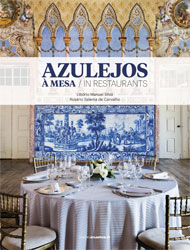|
|
Nesta obra, a Fotografia e a História da Arte uniram-se, uma vez mais, para criar um objecto de singular beleza, onde o poder da imagem e do grafismo se aliam à investigação actualizada, guiando o leitor através da história, da arte e dos autores dos dezassete espaços e dos respectivos revestimentos azulejares que este livro apresenta. O convite sempre renovado à sua visita é agora complementado por uma outra dimensão, a gastronómica.
Portugal é o país dos azulejos, mas é também um país de uma enorme riqueza gastronómica. E se esse não foi um aspecto tido em conta na selecção, será certamente um factor a considerar na utilização deste livro como um roteiro azulejar.
Há vários séculos que os estrangeiros em visita ao nosso país escrevem que o azulejo faz parte da paisagem de Portugal. Como referia Santos Simões, “desde a capela baptismal da igreja, à escola, à cidade, pela vida fora, os portugueses habituaram-se a ver nos azulejos um quadro natural de ambiente” (Simões 1972: 1). Não é por isso de estranhar que o azulejo faça também parte da mesa dos portugueses.
A selecção que este livro apresenta permite acompanhar uma parte muito significativa da história da azulejaria no nosso país, ao mesmo tempo que testemunha a perenidade de uma das artes que mais caracteriza a herança patrimonial portuguesa, quer nos exemplos seculares que se conservam in situ, nos locais para onde o azulejo foi pensado e concebido, quer nas criações contemporâneas que revelam alguns dos factores que desde sempre assinalaram o uso do azulejo em Portugal – monumentalidade, integração e actualidade.
Photography and Art History have thus come together, once more, to create an object of rare beauty, where the power of images and graphic design is accompanied by updated research, revealing the history, artistry and authorship of seventeen different spaces and tile decorations. The ever-renewed invitation to visit these sites is now complemented by their gastronomic appeal.
Portugal is the land of azulejos, but also of a rich gastronomic tradition, and although this aspect was not taken into consideration when selecting the book’s different spaces, it is certainly worth considering when using it as an artistic guide.
For centuries, foreign visitors have identified the azulejo as part of Portugal’s landscape. As Santos Simões once wrote, “from the baptismal chapel to the church, the school, the town and throughout life, the Portuguese have grown used to seeing in azulejos a natural depiction of the surrounding environment” (Simões 1972: 1). It is only natural, therefore, that they should also be part of Portuguese meals.
The selection displayed in this book introduces the reader to a very significant part of the history of Portuguese tile decorations, while highlighting the perennial nature of one of the country’s most distinctive art forms. The latter is visible both in the secular examples still found in their original locations, designed for a specific spatial context, and in contemporary creations preserving some of the aspects that have defined Portuguese tile decorations throughout the ages – monumentality, integration and actuality.
|
|
|
|
|
 |
Azulejos – Maravilhas de Portugal /
Wonders of Portugal
|
|
|
Fotografia / Photography: Libório
Manuel Silva |
|
|
|
Coordenação científica /
Scientific Coordinator: Rosário Salema de
Carvalho |
|
|
|
|
|
Págs:
108 (em capa dura/ hardcover,
24,5cm * 32,1cm) |
|
|
|
ISBN: 978-989-615-215-4 |
|
|
|
1.ª edição / 1st edition:
Set,
2017 |
|
|
|
Preço / Price:
24,99 EUR |
|
|